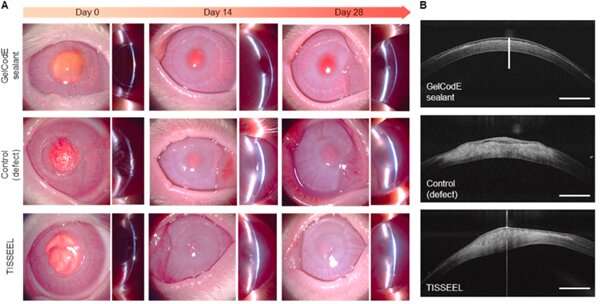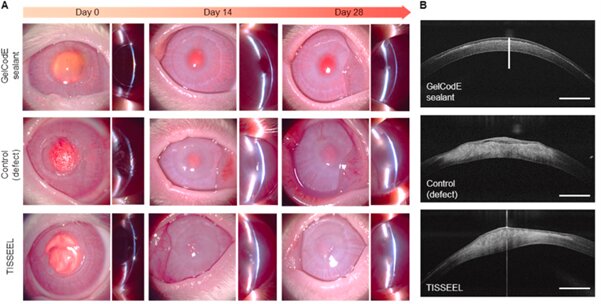
Contact lenses are a popular vision correction option used by about 10% of the population in Korea—roughly 5 to 6 million people—according to statistics from the Korean Ophthalmological Society. A common contact lens care mistake is sleeping with contacts in, which erodes the corneal epithelium, resulting in an eye infection.
Infection can spread enough to produce a corneal wound or ulcer, whose scars may require a corneal transplant. Recently, a Korean joint research team has developed a new tissue adhesive that restores the damaged cornea by simply filling it and exposing it to light.
A joint research team led by Professor Dong-Woo Cho and Dr. Hyeonji Kim (Department of Mechanical Engineering), and Professor Jinah Jang (Department of Convergence IT Engineering) from POSTECH with Professor Joon Young Kim and Professor Je-Hwan Jang (College of Veterinary Medicine) from Konkuk University has succeeded in developing extracellular matrix-based sticky sealants for corneal tissue reconstruction.
This new sticky sealant is able to reconstruct damaged tissues when visible light is irradiated for just three minutes while, unlike previous sealants, integrating well with the adjacent tissues.
Despite great potential over surgical suturing and wound treatment, sticky tissue sealants pose challenges such as uncontrollable adhesion formation, mechanical mismatch, and lack of tissue restoration.
To overcome these issues, the joint research team decided to apply an extracellular matrix that protects and supports cell-assisted restoration by filling the wound area. The extracellular matrix was chosen for tissue reconstruction as it contains a biomolecules responsible for tissue composition and development. Based on this, the researchers developed a new sticky sealant based on gelatinized cornea-derived extracellular matrix (GelCodE) for cornea reconstruction.
Animal experiments found that placing GelCodE in the corneal defect and irradiating diagnostic visible light on the site for three minutes can not only fill the gap but also reconstruct the transparent corneal tissue. Some of the conventional tissue adhesives in clinical use could repair the affected area without transplantation and suturing but failed at tissue reconstruction and integration with the adjacent tissues.
POSTECH Professor Dong-Woo Cho explained, “The new GelCodE enables sutureless and scarless corneal ulcer treatment, which entails fewer steps and complications.” He added, “It is evaluated as having made important progress in regenerative medicine, which emphasizes tissue reconstruction and ease for clinical use.”
The work is published in the journal Biomaterials.
More information:
Hyeonji Kim et al, Extracellular matrix-based sticky sealants for scar-free corneal tissue reconstruction, Biomaterials (2022). DOI: 10.1016/j.biomaterials.2022.121941
Journal information:
Biomaterials
Source: Read Full Article
